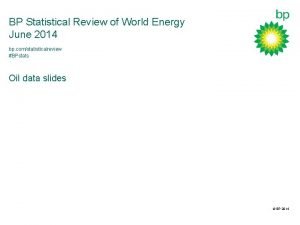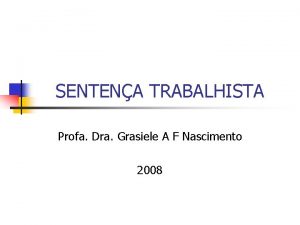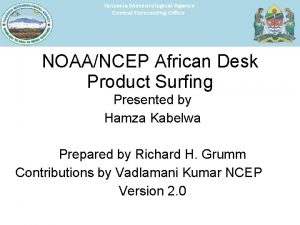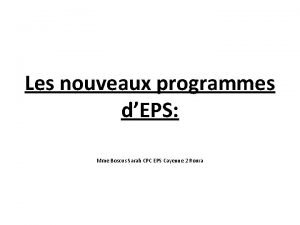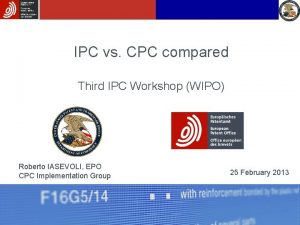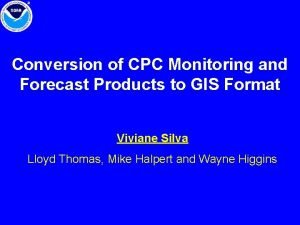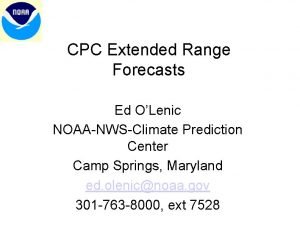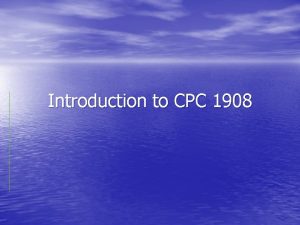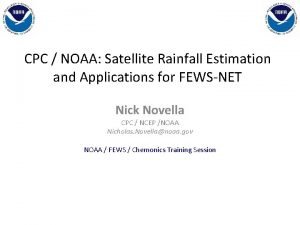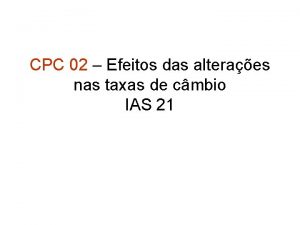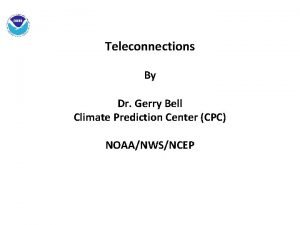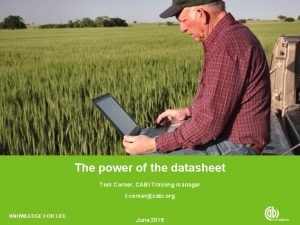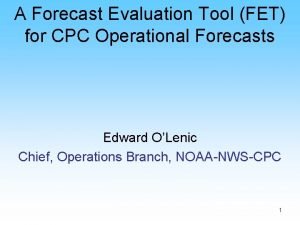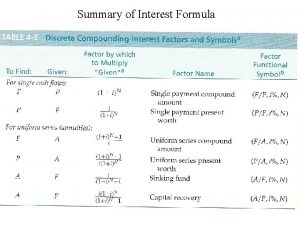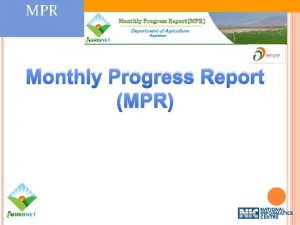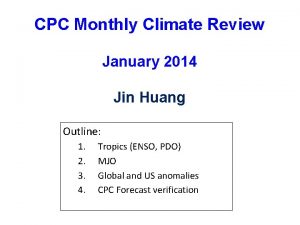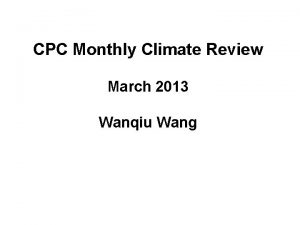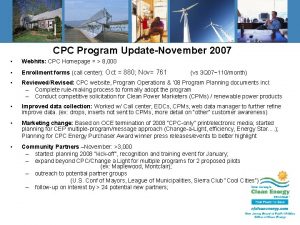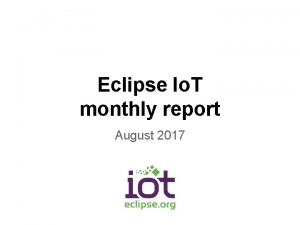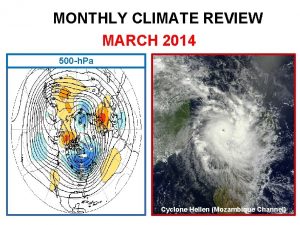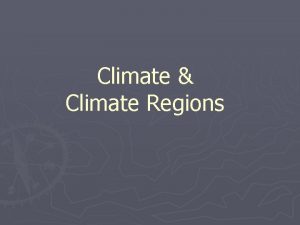CPC Monthly Climate Review August 2014 Yan Xue


























































- Slides: 58

CPC Monthly Climate Review August 2014 Yan Xue Outline: 1. 2. Global Patterns Tropical Climate Variability ENSO, MJO, IOD, TAV, Hurricane Season 3. Extra-Tropical Climate Variability PDO, NAO, Ozone Hole, Monsoon 1. U. S. Climate, Outlooks and Verifications Thanks to Anthony Artusa, Mingyue Chen/Wanqiu Wang, Craig Long, Pingping Xie, Muthu Chelliah, Caihong Wen, Matthew Rosencrans, Michelle L’Heureux, Jon Gottschalck, Wei Shi, Scott Weaver

1. Global Patterns

SST Anomaly (0 C) and Anomaly Tendency PDO= +0. 3 MDR below-normal DMI= -0. 7 ENSO-neutral http: //www. cpc. ncep. noaa. gov/products/GODAS/ocean_briefing. shtml

Upper 300 m Heat Content Anomaly (0 C) and Anomaly Tendency PDO? -DMI Favourable for El Nino http: //www. cpc. ncep. noaa. gov/products/GODAS/multiora_body. html

N. Atlantic below-normal Unfavourable for hurricane E. Pac. above-normal favourable for hurricane

Longitude-Depth Temperature Anomaly and Anomaly Tendency in 1 OS-1 ON http: //www. cpc. ncep. noaa. gov/products/GODAS/multiora_body. html

OLR and 850 mb Wind Anomalies

Sea Surface Salinity (SSS) and E-P Anomaly suppressed precipitation enhanced precipitation From Pingping Xie

2. Tropical Climate Variability ENSO

SST Indices

SOI, Winds and OLR Indices SOI < 0: El Nino-Like SOI > 0: La Nina-Like u 850 < 0: El Nino favorable u 850 > 0: La Nina favorable OLR < 0: El Nino-Like OLR > 0: La Nina-Like

Weekly ENSO Update http: //www. cpc. ncep. noaa. gov/products/p recip/CWlink/MJO/enso. shtml

Depth of 20 C Isotherm Anomaly (2 S-2 N, GODAS) 850 mb Zonal Wind Anomaly (5 S-5 N, NCEP R 1)

Tropical Pacific Observing System

Real-Time Multiple Ocean Reanalysis Intercomparison (http: //www. cpc. ncep. noaa. gov/products/GODAS/multiora_body. html)

Upper 300 m Heat Content Anomaly (1981 -2010 Clim. )

Warm Water Volume Index Derived From Ensemble Mean of Ocean Reanalyses JA 82 JA 91 JA 86 - JA 97 JA 02 JA 06 JA 04 JA 09 JA 12 Warm Water Volume averaged in Jul-Aug 2014 is similar to that in Jul-Aug of 2004, 2006, 2009 and 2012. JA 14

Aug 2004 (DJF NINO 3. 4=+0. 6) Aug 2012 (DJF NINO 3. 4=-0. 6) Aug 2006 (DJF NINO 3. 4=+0. 7) Aug 2014 Aug 2009 (DJF NINO 3. 4=+1. 6)

Upper 300 m Heat Content Anomaly Averaged in 5 S-5 N 14/15 86/87 06/07 02/03 09/10 04/05 12/13

20

too warm forecast Good forecast 21

22

NINO 3. 4 Forecast Plums

2. Tropical Climate Variability MJO

850 -h. Pa Vector Wind Anomalies (m s-1) Note that shading denotes the zonal wind anomaly Blue shades: Easterly anomalies Red shades: Westerly anomalies increased. Monsoon flow increased over Africa and persisted over South Asia. the tropical Atlantic. Weak easterly anomalies spread across the westcentral Pacific. Westerly anomalies increased north of the equator over the eastern Pacific, with weak anomalies on the equator.

200 -h. Pa Velocity Potential Anomalies (5°S-5°N) Positive anomalies (brown shading) indicate unfavorable conditions for precipitation Negative anomalies (green shading) indicate favorable conditions for precipitation A slow eastward progression of negative anomalies was observed from January to present across the Indo-Pacific warm pool and central Pacific (red box). During February through April, anomalies propagated eastward with time associated with the MJO before weakening for much of May. Time The pattern became more organized during June with a more coherent wave-1 MJO-like structure with eastward propagation. The pattern became less coherent during July and August as other modes of subseasonal tropical variability, e. g. , equatorial Rossby and Kelvin wave activity, became the more dominant signals. More recently, the signal strengthened with some eastward propagation. Longitude

CFSv 2 Precipitation Forecast

CFSv 2 850 mb Wind Forecast

2. Tropical Climate Variability IOD, TAV, Hurricane

Evolution of Indian Ocean SST Indices - Negative DMI enhanced in August. Fig. I 1 a. Indian Ocean Dipole region indices, calculated as the area-averaged monthly mean sea surface temperature anomalies ( OC) for the SETIO [90ºE-110ºE, 10ºS-0] and WTIO [50ºE-70ºE, 10ºS-10ºN] regions, and Dipole Mode Index, defined as differences between WTIO and SETIO. Data are derived from the NCEP OI SST analysis, and anomalies are departures from the 1981 -2010 base period means.

Evolution of Tropical Atlantic SST Indices - Tropical North Atlantic (TNA) index was negative since Jan 2014. - Tropical South Atlantic (TSA) index continued to be near -normal. - Meridional Gradient Mode (TNA-TSA) remained negative. - Negative ATL 3 SSTA strengthened in Aug. 2014. Fig. A 1 a. Tropical Atlantic Variability region indices, calculated as the area-averaged monthly mean sea surface temperature anomalies (ºC) for the TNA [60ºW-30ºW, 5ºN-20ºN], TSA [30ºW-10ºE, 20ºS-0] and ATL 3 [20ºW-0, 2. 5ºS-2. 5ºN] regions, and Meridional Gradient Index, defined as differences between TNA and TSA. Data are derived from the NCEP OI SST analysis, and anomalies are departures from the 1981 -2010 base period means.


2014 Atlantic Hurricane Counts (http: //weather. unisys. com/hurricane) - Atlantic Outlook (Aug update): 7 -12 Named Storms (12 average) 3 -6 Hurricanes (6 average) 0 -2 Major Hurricanes (3 average)

2014 E. Pacific Hurricane Counts (http: //weather. unisys. com/hurricane) - E. Pacific Outlook (50% above-normal): - E. Pacific Counts by Sep 6: 14 -20 Named Storms (15 average) 15 Named Storms 7 -11 Hurricanes (8 average) 3 Hurricanes 3 -6 Major Hurricanes (4 average) 7 Major Hurricanes

The strongest tropical cyclone ever recorded in May # Name 1 Hurricane-4 AMANDA 2 Tropical Storm BORIS 3 Hurricane-4 CRISTINA 4 Tropical Storm DOUGLAS 5 Tropical Storm ELIDA 6 Tropical Storm FAUSTO 7 Tropical Storm WALI 8 Hurricane-5 GENEVIEVE 9 Hurricane-1 HERNAN 10 Hurricane-4 ISELLE 11 Hurricane-3 JULIO 12 Hurricane-1 KARINA 13 Hurricane-1 LOWELL 14 Hurricane-5 MARIE 15 Hurricane-3 NORBERT Win Pres Cat d 22 -29 MAY 135 4 02 -04 JUN 35 - 09 -15 JUN 130 4 28 JUN-05 JUL 40 - 30 JUN-02 JUL 45 - 07 -09 JUL 40 - 17 -19 JUL 40 - 25 JUL-11 AUG 140 5 26 -29 JUL 65 1 31 JUL-09 AUG 120 4 04 -15 AUG 105 3 13 -27 AUG 70 1 18 -24 AUG 65 1 22 -29 AUG 140 5 02 -07 SEP 105 3 Active Date the strongest tropical cyclone on record to strike the Big Island of Hawaii

3. Extra-Tropical Climate Variability PDO, NAO, Ozone Hole, Monsoon

PDO index - PDO has been in positive phase since Mar 2014, and PDO index = +0. 3 in August 2014. - Pacific Decadal Oscillation is defined as the 1 st EOF of monthly ERSST v 3 b in the North Pacific for the period 19001993. PDO index is the standardized projection of the monthly SST anomalies onto the 1 st EOF pattern. - The PDO index differs slightly from that of JISAO, which uses a blend of UKMET and OIv 1 and OIv 2 SST.

NAO and SST Anomaly in North Atlantic - NAO was well below-normal , with NAO= -2. 3 in August 2014. - Large positive SST anomaly presented near the east coast of Canada and Norwegian Sea. - High-latitude North Atlantic SSTA are reversely related to NAO index (negative NAO coincides with to SST warming). Fig. NA 2. Monthly standardized NAO index (top) derived from monthly standardized 500 -mb height anomalies obtained from the NCEP CDAS in 20ºN-90ºN (http: //www. cpc. ncep. noaa. gov). Time-Latitude section of SST anomalies averaged between 80ºW and 20ºW (bottom). SST are derived from the NCEP OI SST analysis, and anomalies are departures from the 1981 -2010 base period means.

From Craig Long

The black line highlights the -78 C isotherm. Temps colder than -78 C are required to form polar stratospheric clouds upon which solar driven ozone depletion occurs.

Recent Heavy rains, Floods and mudslides in northern India in Kashmir region. (1 -7 Sep. 2014). Forecast anom Observed anom From Muthu Chelliah • India 2104 summer monsoon rainfall, so far this season (since 1 st June) is about 11% BELOW normal. This is much improved compared to about 45% below normal earlier in the season.

4. U. S. Climate, Outlooks and Verifications

U. S. Temperature and Precipitation Departures During the Last 30 Days End Date: 31 August 2014 Percent of Average Precipitation Temperature Departures (degree C) 1 of 2

S ro U i. D n t. M h g u y. Jl 2 u 4 1 , 0 9 M m M E T m m V E A B T S : elif. DU: IRLDS p h g to /n u d lim rucgoenpatsdy)D, h(. r 6 L=-x 4 v 321 b 0 J 8 enafocgup. ST. e DROUGHT MONITOR - Low water levels are visible at the Almaden Reservoir on January 28, 2014 in San Jose, Calif.

AUG TEMP AUG PRCP Sept 2014 Outlook

SON 2014 Outlook





Thanks!

Global Temperatures

Global Precipitation

U. S. Temperature and Precipitation Departures During the Last 90 Days End Date: 31 August 2014 Percent of Average Precipitation Temperature Departures (degree C) 2 of 2


Mar 1 Jun 1 Apr 1 Jul 1 May 1 Aug 1

Aug 2004 (DJF NINO 3. 4=+0. 6) Aug 2012 (DJF NINO 3. 4=-0. 6) Jul 2006 (DJF NINO 3. 4=+0. 7) Jul 2009 (DJF NINO 3. 4=+1. 6) Aug 2014 5 S-5 N Average

Westerly bias Good forecast 58
 Climate change 2014 mitigation of climate change
Climate change 2014 mitigation of climate change Monthly operational review
Monthly operational review Chenghai xue
Chenghai xue Xuele
Xuele Xuele moe edu sg
Xuele moe edu sg Harvard catalyst biostatistics
Harvard catalyst biostatistics Fast distributed deep learning over rdma
Fast distributed deep learning over rdma Difference between atomic and molecular spectroscopy
Difference between atomic and molecular spectroscopy Qian li xue
Qian li xue Yao tong xue
Yao tong xue Bp statistical review of world energy 2014
Bp statistical review of world energy 2014 Art 294 a 311 cpc
Art 294 a 311 cpc Artigo 775 cpc
Artigo 775 cpc Art. 131 cpc
Art. 131 cpc Noaa africa desk
Noaa africa desk Sarah-cpc
Sarah-cpc Cpc ipc
Cpc ipc Modulation corollary
Modulation corollary Artigo 783 do cpc
Artigo 783 do cpc Noaa corps cpc
Noaa corps cpc Cpc monitoring
Cpc monitoring Que es c.p.c. en contabilidad
Que es c.p.c. en contabilidad Ruy pereira camilo junior
Ruy pereira camilo junior Artigo 775 cpc
Artigo 775 cpc Importancia de la demanda
Importancia de la demanda Prezentare google
Prezentare google Cpc long range forecast
Cpc long range forecast Cpc lab test
Cpc lab test Cpc cpma
Cpc cpma Civil procedure 1908
Civil procedure 1908 Cpc moodle
Cpc moodle Noaa precipitation data
Noaa precipitation data Cpc cycle kelly
Cpc cycle kelly Actualizar cpc
Actualizar cpc Cpc vale do rio doce
Cpc vale do rio doce Art 610 cpc
Art 610 cpc Dr grace ng
Dr grace ng Cpc 02
Cpc 02 Cpc cabi
Cpc cabi Fraude contra credores cpc
Fraude contra credores cpc Testamento particular novo cpc
Testamento particular novo cpc Cpc pna
Cpc pna Prazo para abertura de inventário novo cpc
Prazo para abertura de inventário novo cpc Cab abstracts ebsco
Cab abstracts ebsco Cpc assessment tools
Cpc assessment tools Traffic engineering studies
Traffic engineering studies Monthly wife
Monthly wife The good wife's guide 1955
The good wife's guide 1955 Discrete compounding
Discrete compounding Mdm daily sms format
Mdm daily sms format Parho punjab barho punjab
Parho punjab barho punjab Omma complaint
Omma complaint Effective interest rate
Effective interest rate Jim1 nhs monthly
Jim1 nhs monthly Mpr report format
Mpr report format Monthly marketing report
Monthly marketing report Hmis forms
Hmis forms Monthly planner 2010
Monthly planner 2010 Interesting sabbath school topics
Interesting sabbath school topics










